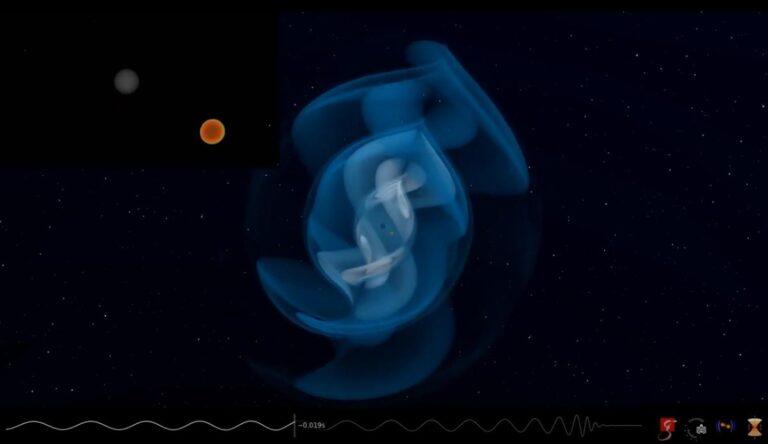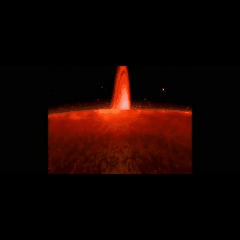詹姆斯·韦伯太空望远镜发现年轻超新星遗迹中心存在中子星的证据
NASA的詹姆斯·韦伯太空望远镜在最近观测到的一颗超新星的位置发现了中子星辐射的最佳证据。这颗被称为SN 1987A的超新星是一颗核心坍缩超新星,这意味着其核心被压缩的残骸形成了一颗中子星或一个黑洞。

NASA的詹姆斯·韦伯太空望远镜在最近观测到的一颗超新星的位置发现了中子星辐射的最佳证据。这颗被称为SN 1987A的超新星是一颗核心坍缩超新星,这意味着其核心被压缩的残骸形成了一颗中子星或一个黑洞。

使用NASA的两台X射线望远镜,研究人员能够放大一颗死星释放出明亮、短暂的无线电波爆发时的不稳定行为。

精美的、前所未见的细节有助于揭开超新星遗迹令人费解的历史。

2022年8月21日 The Spinning Pulsar of the Crab Nebula Image Credit: NASA: X-ray: Chandra (CXC), Optical: Hubble (STScI), Infrared: Spitzer (JPL-Caltech) Explanation: At the core of the Crab Nebula lies a city-sized, magnetized neutron star spinning 30 times a second. Known as the Crab Pulsar, it is the bright spot in the center of the gaseous swirl at the nebula’s core. About twelve light-years across, the spectacular picture frames the glowing gas, cavities and swirling filaments near the Crab Nebula’s center. The featured picture combines visible light from the Hubble Space Telescope in purple, X-ray light from the Chandra X-ray Observatory in blue, and infrared light from the Spitzer Space Telescope in red. Like a cosmic dynamo the Crab pulsar powers the emission from the nebula,…

2021年7月14日 GW200115: Simulation of a Black Hole Merging with a Neutron Star Video Credit: Simulation: S.V. Chaurasia (Stockholm U.), T. Dietrich (Potsdam U. & MPIGP); Visualization: T. Dietrich (Potsdam U. & MPIGP), N. Fischer, S. Ossokine, H. Pfeiffer (MPIGP) Explanation: What happens when a black hole destroys a neutron star? Analyses indicate that just such an event created gravitational wave event GW200115, detected in 2020 January by LIGO and Virgo observatories. To better understand the unusual event, the featured visualization was created from a computer simulation. The visualization video starts with the black hole (about 6 times the Sun’s mass) and neutron star (about 1.5 times the Sun’s mass) circling each other, together emitting an increasing amount of gravitational radiation. The picturesque pattern of gravitational…

2021年02月09日 Flashes of the Crab Pulsar Video Credit & Copyright: Martin Fiedler Explanation: It somehow survived an explosion that would surely have destroyed our Sun. Now it is spins 30 times a second and is famous for the its rapid flashes. It is the Crab Pulsar, the rotating neutron star remnant of the supernova that created the Crab Nebula. A careful eye can spot the pulsar flashes in the featured time-lapse video, just above the image center. The video was created by adding together images taken only when the pulsar was flashing, as well as co-added images from other relative times. The Crab Pulsar flashes may have been first noted by an unknown woman attending a public observing night at the University of Chicago in…

2019 December 18 A Hotspot Map of Neutron Star J0030’s Surface Image Credit: NASA, NICER, GSFC’s CI Lab Explanation: What do neutron stars look like? Previously these city-sized stars were too small and too far away to resolve. Recently, however, the first maps of the locations and sizes of hotspots on a neutron star’s surface have been made by carefully modeling how the rapid spin makes the star’s X-ray brightness rise and fall. Based on a leading model, an illustrative map of pulsar J0030+0451’s hotspots is pictured, with the rest of the star’s surface filled in with a false patchy blue. J0030 spins once every 0.0049 seconds and is located about 1000 light years away. The map was computed from data taken by NASA’s Neutron…

2019 September 3 Unusual Signal Suggests Neutron Star Destroyed by Black Hole Illustration Video Credit: NASA, Dana Berry (Skyworks Digital) Explanation: What created this unusual explosion? Three weeks ago, gravitational wave detectors in the USA and Europe — the LIGO and Virgo detectors — detected a burst of gravitational radiation that had the oscillating pattern expected when a black hole destroys a neutron star. One object in event S190814bv was best fit with a mass greater than five times the mass of the Sun — making it a good candidate for a black hole, while the other object appeared to have a mass less than three times the mass of the Sun — making it a good candidate for a neutron star. No similar event…